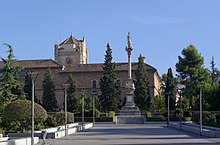Universidad de Granada
 |
|
| Latin: "Universitas Granatensis" | |
| Established | 1531 |
|---|---|
| Endowment | 395,663,000 € |
| Rector | Pilar Aranda Ramírez |
|
Administrative staff
|
3,400 |
| Students | 80,000 |
| Location | Granada, Spain |
| Affiliations | Coimbra Group, UNIMED |
| Website | http://www.ugr.es |
 |
|
The University of Granada (Spanish: Universidad de Granada, UGR) is a public university located in the city of Granada, Spain, and founded in 1531 by Emperor Charles V. With approximately 80,000 students, it is the fourth largest university in Spain. Apart from the city of Granada, UGR also has campuses in Northern Africa (Ceuta and Melilla).
Every year over 2,000 European students enroll in UGR through the Erasmus Programme, making it the most popular European destination. The university's Center for Modern Languages (CLM) receives over 10,000 international students each year. In 2014, UGR was voted the best Spanish university by international students.
In 1526 a college was founded in Granada by Holy Roman Emperor Charles V for the teaching of logic, philosophy, theology and canon law. On 14 July 1531, the establishment of a studium generale with the faculties of theology, arts and canon law was granted by a papal bull by Clement VII, marking the birth hour of the university.
The university has an important heritage thanks to its policy of using buildings of historical and cultural value such as the former madrasah and the former Royal Hospital of Granada. Furthermore, the university has major new facilities committed to innovation, such as the .
According to several rankings, the University of Granada ranks among top ten best Spanish universities and holds first place in Translation and Interpreting studies. It is also considered the national leader in Computer Science Engineering. UGR also plays a major role in scientific output, placing high in national ranks and being one of the best world universities in computing and mathematics studies.
...
Wikipedia
